Hunting Wynfield Planation in Georgia’s Wild Quail Belt
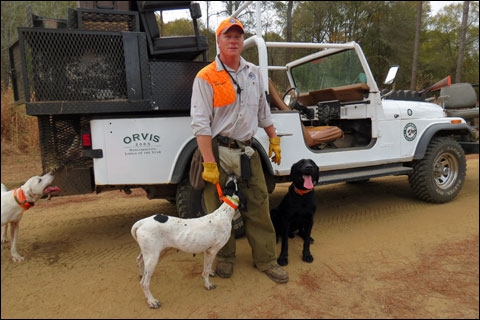
The town of Albany figures large in Southern Georgia’s legendary bobwhite quail culture. Most of the year Albany hosts some 76,000 everyday residents, but from November through February the local Southwest Georgia Regional Airport is jam-packed with high-net-worth luxury personal jets conveying quail hunters, their dogs, shotguns, family, friends and business associates,
“I was at the airport this morning, and one of the plantation owners flew in on his private jet. And during hunting season, there are always five or six private jets at a time flying in, the hunters staying in the community, eating at our restaurants. The plantation owners pay millions of dollars in taxes, and quail hunting is a huge industry here.” Dr. Frank Middleton told the Albany Herald Newspaper of July 17, 2015.
In fact, the Greater Albany Region Community Empowerment Fund attributes wild quail hunting with pumping $125 million into the region. In the Fund’s economic study, the operative word is “wild.” Because wild quail hunting means private quail plantations – and modest Albany boasts a very high concentration owned by captains of industry.
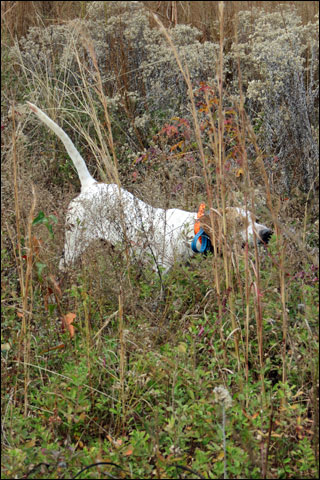
On point at Wynfield Plantation.
In addition to spending anywhere from $10 million to $30 million for the purchase of a wild quail plantation, the owners then spend tens of thousands per year nurturing and grooming their ideal habitat. You can witness explosive coveys of 20 to 30 birds, but the daily limit may be 10 for the entire party to preserve the natural order.
For instance, watch his video clip posted by local planation real estate specialist Jon Kohler and Associates: https://goo.gl/Hqh7ih
The hunts often involve mule-drawn bird buggies and Tennessee walking horses for hunters and guides in a convention of pageantry evocative of the Gilded Age. And if you’re fortunate to even rent a private plantation during the season, prepare to spend upwards of $60,000 per week for the privilege of stalking wild bobwhites.

Kurt Guthrie, Wynfield Plantation’s General Manager, on the lodge front porch with his dog.
However, smack in the middle of Albany’s private quail plantation motherland sits Wynfield Planation – the award winning quail preserve that lets us hunt among the bobwhite royalty of Southwest Georgia. And for far less than $60,000 you can dip into your checking account to experience quail hunting that’s been cultivated and refined through generations of local wisdom and lore from folks who have learned it from their forbearers.
The depth of know-how and a nod to Southern hospitality helped Wynfield Plantation attain “Orvis Wingshooting Lodge of the Year” in 2005, named in 2006 as “One of the Top Twenty Wingshooting Destinations in the World” by legendary wingshooting author and editor Steve Smith in his book A Wingshooter’s World and voted one of the “Top Fifty People, Places and Things in the South” by Garden and Gun Magazine.
“Eighty percent of our clients come back every year,” confided Kurt Guthrie, Wynfield Plantation’s General Manager. “We believe the best way to attract business is through word of mouth.”
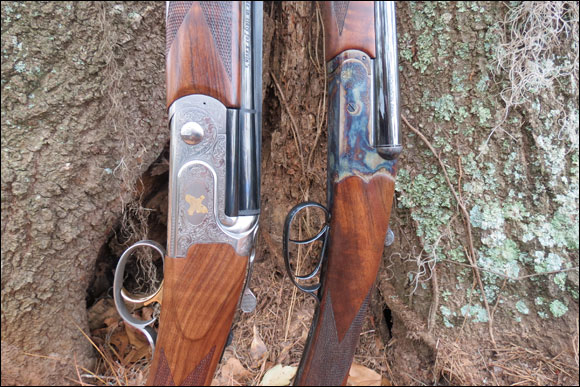
At Wynfield Plantation we shot the 20-gauge Kevin’s Plantation Golden Quail (left) and the 28-gauge/.410 two-barrel set Dickinson Estate.
Alive with the culture of wild quail hunts, Wynfield Plantation’s explosive coveys and strafing break-aways provided us the occasion for a baptism by fire for two new bird guns.
Getting thrown into the quail fray were a Dickinson Estate sub-gauge, two-barrel set and a 20-gauge Kevin’s Plantation Golden Quail.
In 2015 I had purchased a Dickinson Estate. The side-by-side, boxlock is a 28-gauge scaled frame that also included .410 barrels. Twenty-eight-inch barrels came with flush, screw-in chokes for the 28 gauge while the .410 is fixed full/full. Made by Turkish manufacturer, Akus, the seven-pound Dickinson Estate is sold exclusively through Cabela’s. I’d been inspired to purchase the two-barrel Dickinson Estate after shooting clays with the 28 gauge. The balanced and elegant handling far surpassed expectations of price, performance and origin.
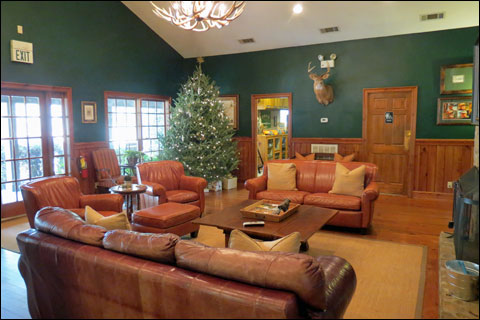
Here’s the Wynfield Plantation lodge decorated for Christmas, when we hunted there.
Likewise, the Dickinson’s aesthetics and cosmetics cast a seductive spell. The scalloped case-colored receiver benefits from the bone-and-wood charcoal process that created a glossy oil-slick finish. Barrel gloss appeared smooth and deep. A straight English grip with checkered butt, hand checkering and splinter forend exceeded the workmanship and walnut grade of the $2,400 package. Its double triggers executed with usual field-grade resistance. Ultimately, the Dickinson Estate borrowed enough panache from its old English namesake to present itself as a classic double birder at a persuasive price. Because of red tap I was unable to purchase the demo gun so ordered a new one instead.
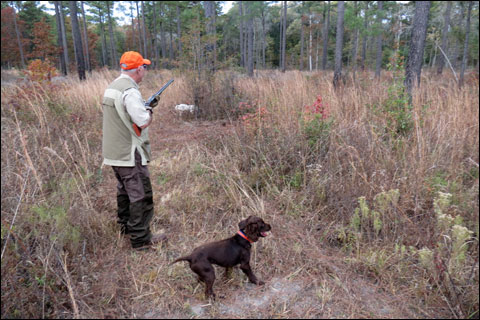
The author ready for an explosive covey flush at Wynfield Plantation.
When my Dickinson arrived, I immediately took it for sporting clays and was horrified at the nine-pound triggers – far heavier than the version I’d shot and about twice as hard as most field guns. With triggers that stubborn any chance of immediate, instinctive shooting is overwhelmed by the sheer frustration of manhandling the shotgun.
I called Cabela’s who recommended a gunsmith in Colorado experienced with the Dickinson line and its predecessor, the Smith & Wesson Elite. The gunsmith was old school: no email, no web site, no texting and no credit cards. He could lighten the triggers to 4½ pounds. Length of pull came up a tad short so I requested a vintage red recoil pad to replace the wood butt plate. Price with shipping: $456.00.
Weeks later my Dickson Estate showed up with scary gaps between triggers and stock − the recoil pad defaced with grease. When I complained, the gunsmith asked that I return it. The Dickinson subsequently appeared as-new accompanied by a one-hundred dollar bill for my trouble. After sitting idle in the safe for nearly 12 months, I anticipated that Wynfield’s bobwhites would actually perform a real-world audition for the overhauled Dickinson Estate.
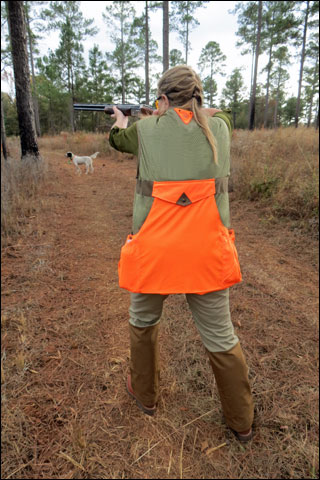
Shotgun Life Editor, Deborah McKown, bagging a single with her Kevin’s Plantation Golden Quail.
My hunting companion, Shotgun Life Editor, Deborah McKown, had recently purchased a Kevin’s Plantation Golden Quail. In the Plantation series of Kevin’s premium shotguns, the 20-gauge Golden Quail appeared in mid-2016 as an entry model pre-order priced a $2,195. (Read our review of the shotgun.)
Her Golden Quail over/under sported 28-inch barrels, five screw-in chokes and a Prince of Wales grip with rounded knob, and Prince of Wales forend, rated at Grade 4 Turkish walnut. The bright receiver presented scroll engraving and three gold inlaid quail in flight and roses on the trigger guard.
Mike Burnett, Kevin’s Gun Manager, substituted the wood butt plate for the included recoil pad more to her liking. She initially shot the Kevin’s Plantation Golden Quail on wobble trap – smashing 23 of 25. Realizing it felt too long, Mr. Burnett arranged for the stock to be shortened. Freshly fitted, the Plantation Golden Quail would be aptly inaugurated on the quarry of Wynfield Plantation.
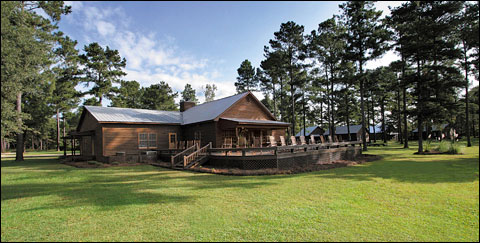
The rear of Wynfield Plantation’s lodge, with the five cabins visible to the right.
A sweeping road leads to the Wynfield Plantation lodge as the low, pastoral buildings rolled into view. Turn off the engine and it takes a few moments to realize there’s a distinctive serenity about the place – the relationships of natural light and space and architecture at peace with the long-leaf pines and lake vista.
I’d discover from Mr. Guthrie the setting intended to welcome you with a slow unfolding of gracious Southern geniality. But there was something more. Wynfield Planation preserved a harmonious scale by moving the rooms out of the lodge into five cozy, private cabins, while the bar and related fun stuff was in the homespun lakeside pavilion. The down-to-earth nature of it seemed to revive long-ago idylls of jubilant gatherings at a lake-side “family camp” in woods aromatic of pine. Step out of your car, breathe the air and you’re awash in wellbeing.
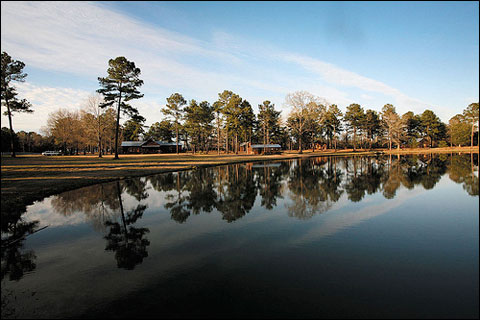
The lake at Wynfield Plantation.
We checked into our cabin, each of the two bedrooms with a bathroom. Although it was afternoon, the comfortably furnished living room radiated a nostalgic warmth from an array of parchment-hued lampshades. Shortly, though, our trapper appeared in his Jeep Wrangler for a round of warm-up sporting clays. Navigating a narrow trail, we reached station one. The 10-station course proved deceptively difficult. When launched, the presentations seemed easy but then performed a few surprising acrobatics in the spirt of flushing quail.
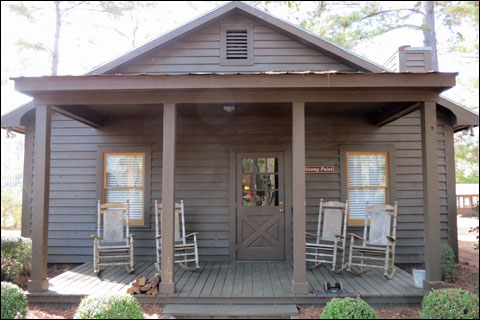
Our private cabin at Wynfield Planation. Inside, it was cozy and comfortable.
Lunch in the light-filled dining room served up home-cooked grilled pork chops and fluffy mashed potatoes with brown gravy, vegetables and corn muffin followed by a brownie sundae for dessert. As Kurt said, “We like to prepare Southern food like fried chicken, fried quail and mac-n-cheese.”
Fueled up, it was time to hunt.
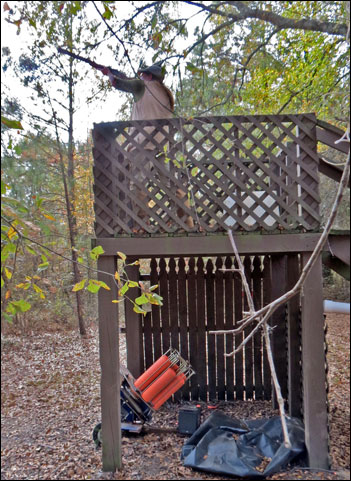
Shotgun Life Editor Deborah McKown shooting sporting clays at Wynfield Plantation.
We piled onto the Jeep Wrangler bird buggy under the guidance of local veteran Tommy Bridges. The kennels held six eager Pointers and two Cockers – the dogs yapping and scratching in anticipation of the hunt. I opted for one of the swivel seats mounted on the Jeep’s front basket. Now in motion, sitting in point position, the essence of Georgia’s wild quail splendor caressed my face as we traversed the rutted track to our first hunt. I could hear Deb and Tommy laughing. Under a bluebird sky of soft winter, the land felt blessed and bountiful across the timeless expanse of Wynfield Plantation.
Tommy stopped in a wiregrass meadow on the threshold of hardwood stands lush with a carpet of pine straw. He collared a Pointer and Cocker. The dogs led us toward the trees and within a few paces the Pointer locked up. We flanked Tommy. On command, the Cocker charged into the shrub, raising a single bobwhite. Deb effortlessly shouldered her shotgun and brought down the bird with the first shot, easy as pie. The Kevin’s Plantation Golden Quail satisfied her expectations and established an upbeat atmosphere from the outset.
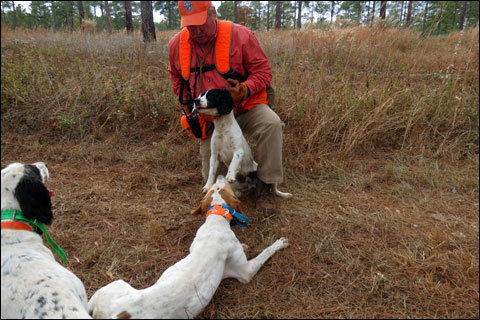
Guide Tommy Bridges prepares his dogs for an afternoon of bobwhite quail hunting.
The second point sparked a small covey with most of the quail bunching into my purview. I missed the first attempt with the 28-gauge barrels but the second downed a bird at about thirty yards via an improved cylinder choke. The triggers performed flawlessly.
More impressive, though, the barrel regulation delivered pitiless point-where-you-shoot reckoning that gradually stretched my range throughout the hunts at Wynfield Plantation. The reach of the Dickinson Estate emboldened me to take long shots that otherwise I would’ve relinquished – becoming one of those field guns that helped you look good to the magnitude of bagging a double, with the second bird incredibly far away.
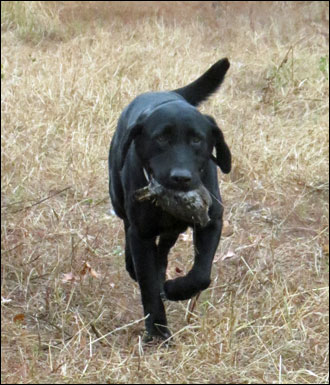
Bringing in one more quail for the cooler.
Our afternoon unwound in a succession of hunts enlivened by Tommy’s bird dog stories. Tommy possessed that Southern oratory mastery of storytelling with an intoxicating accent that echoed back through time when men and their dogs walked the fence line for wild bobwhites.
We finished with 18 flushes, including healthy 10 coveys, before returning to our cabin.
Dinner in the lodge surprised me with the best quail I’ve ever eaten. Our quail two ways presented one variety sautéed in a maple and cherry reduction sauce, although the true star was chef’s fried Tabasco and honey recipe with its swirl of crunch, heat and rich sweetness. Afterwards, on the back deck, we enjoyed the sundowner breeze and view of the lake over a Woodford Reserve bourbon.
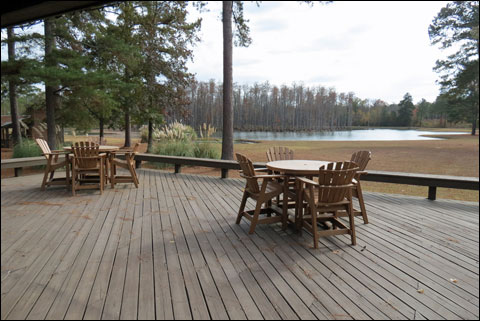
The rear deck of Wynfield Planation’s lodge where we enjoyed after-dinner drinks.
The following morning, bright and windy, I walked past several cabins to the lodge – dogs’ barking from the plantation kennels carrying across the lake. After a traditional big breakfast in the dining room, I hunted alone with guide Shawn Vallandingham and his Labs. The wind convinced me to stick with the Dickinson Estate’s 28 gauge barrels instead of shifting to the .410.
Shawn understood this land, having worked it for decades even before the current ownership acquired the property in 1986, where it now covers 2,000 acres. We methodically traversed numerous courses behind his dogs. Finally, leading up to lunch, I bagged 24 quail through 12 coveys and plenty of singles and doubles – as my streak of far-off shots with the Dickinson Estate continued to pay in dropped birds.
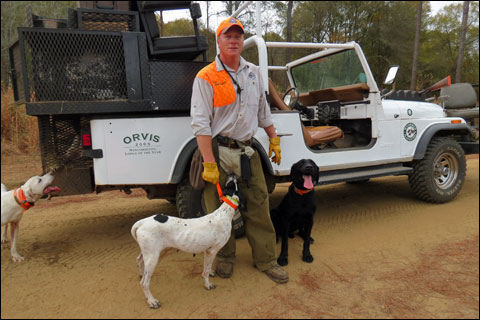
Wynfield Plantation guide Shawn Vallandingham.
Our adventure at Wynfield Planatation concluded with a cooler full of quail packed into the car.
Hunting Wynfield Planation you begin to understand that the legacy of wild bobwhites embraces more than just the birds. It’s also a wingshooting institution of place and traditions. The generations of people involved tend to treat you the same, whether you’re paying $60,000 for a weekend of hunting or $800. The corridor between Albany and Thomasville, Georgia is among the most active field-trial regions in America with those championship bloodlines coursing through the dogs that lead you to birds.
Around here, when it comes to private quail plantations or quail preserves, you share same perfumed air, experience the same dogs and walk the same hallowed ground.
Irwin Greenstein is the publisher of Shotgun Life. You can reach him at www.shotgunlife.com.
Useful resources:
The Wynfield Planation web site
The Dickinson Estate page on the Cabela’s web site

Irwin Greenstein is Publisher of Shotgun Life. Please send your comments to letters@shotgunlife.com.


Comments